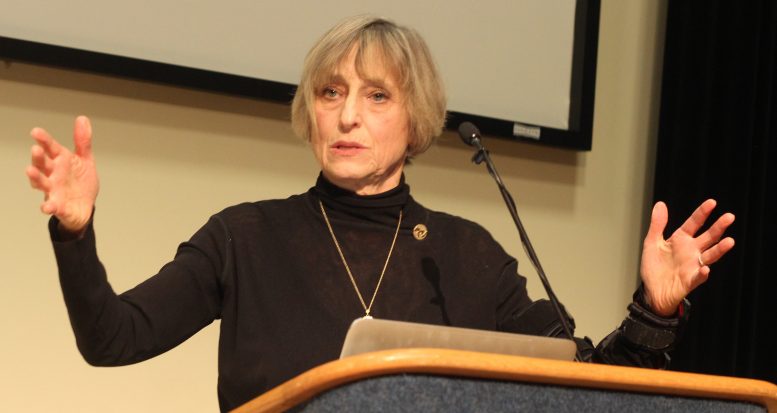By DAVID DUPONT
BG Independent News
Lana Pollack got her first taste of government regulation, or protection as she prefers to call it, when she was a girl watching beef being butchered.
As the Lamb Peace lecturer, Pollack, who chairs the U.S. section, International Joint Commission, kicked off Earth Week at Bowling Green State University posing the question: “If protections are good, why are regulations bad?”
Certainly her father who ran a grocery store and butcher shop in rural western Michigan didn’t appreciate the state inspector who stood by while he and his help processed a beef carcass.
Her father, Pollack said, was the kind of person who fed a lot of people whether they could pay their bills or not. Once a week he’d go to the cattle auction and buy a couple steers, which he’d bring back. Pollack said she went along, and watched the processing. “I know where my meat comes from.”
She could see her father was “aggravated” by the inspector and his seemingly petty demands.
In his later years, his daughter asked him if the state regulations made his ground beef or hot dogs any better.
No, he said. “But it kept the guy down the road from adding sawdust to his hot dogs.”
The consumer wasn’t protected from an ethical business like the one her father ran, but from the unethical ‘guy down the road.”
That holds true for the environment as well, including the Great Lakes.
That’s why the EPA is the Environmental Protection Agency, not the Environmental Regulatory Agency. People like “protection,” she said. They think far less of regulations, especially when they are so constantly referred to as “job-killing regulations.”
That phrase is tossed around so much that it almost becomes one word. It’s a favorite of conservative lobbying efforts like the American Legislative Exchange Council.
“Words matter,” Pollack said.
It’s not like businesses, including agribusiness, are opposed to government action, she said. They’re fine with it as long as it benefits them.
While agribusiness may fight rules aimed at controlling the run-off of phosphorus from fields that causes toxic algae blooms in Lake Erie, farm interests back federal government support for ethanol production, Pollack said. Now 40 percent of corn on 7 million acres of heavily fertilized cropland is grown for fuel.
Taking action to combat pollution of the Great Lakes is a complex issue that involves understanding the science, as well as the cultural and political context.
Pollack, who served in the Michigan State Senate from 1984 to 1993, describes herself as “a recovering politician.”
At her lecture she showed two photos of the Cuyahoga River on fire, one from 1952 and the other from 1969.
No action was taken in 1952 in the years of complacency after World War II. But the 1960s was a “time of social revolution” and “progressive change.” The burning river caught the public’s attention. Action was taken.
Citizens agitated for environmental protections
That action had beneficial effects. It dramatically reduced the amount of PCPs going into the Great Lakes. And it reduced the amount of phosphorus going into the lakes. That came by the removal of phosphorus, which promote algae growth, from washing detergents and commercial lawn care products.
And it came from billions being invested into water treatment systems – which are now aging, she noted.
But federal action also did harm. The Clean Water Act, for example, exempted “nonpoint pollution,” that is runoff that cannot be traced to a specific source. That means farmland. Even now, Pollack said, officials are not allowed to determine “hot spots” on fields that generate more fertilizer run off.
Lax regulations also promoted the development of Concentrated Animal Feeding Operations, which are concentrated sources of pollutants.
Agriculture accounts for 75 percent of the runoff. Wastewater treatment systems are the next largest contributors at 9 percent. Methane released by the lakes themselves as material rots account for 3 to 7 percent, according to new research. Urban runoffs and septic systems account for about 4 percent each.
The shipping industry also lobbied successfully for years to delay rules to protect the Great Lakes from the invasion of zebra mussels.
All this is complicated by climate change, Pollack said, because warmer temperatures foster algae growth. More extreme weather patterns also accelerate the flow of pollutants to the lake.
The international commission, established by the U.S. and Canada to address issues related to boundary waters including the Great Lakes, has no legislative, funding, or regulatory powers. It does advocate for a “Balanced Diet for Lake Erie.”
That calls for a 37-41 percent in the amount of phosphorus going into the lake. Best practices to control runoff from farmland must be developed, studied, and shared. Good farmers have a lot to teach bad farmers, she said, and teach politicians and regulators.
Federal support to farmers should be linked to farm practices. Wetlands need to be rebuilt and environmentally friendly infrastructure promoted. And action plans with “enforceable protections” need to be developed by both the United States and Canada.
Pollack said, though, this gets more difficult as federal legislators talk about moving these actions down to the state level. ALEC has already said that’s what it wants. The conservative group is already active within state legislatures.
“The deeper longer and rougher the discussion is on regulations being bad, ‘job killing regulation,’ the more trouble we’ll be in,” Pollack concluded. “The culture that’s convinced that environmental protections are nothing more than unnecessary, burdensome regulations is a culture that will soon find itself without any protections”


